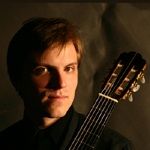So I need to post SOMETHING about Bill K's concert and master class. Here's an analysis...
Concert
Bill started out strong with de Falla's "The Miller's Dance." This is particularly amazing because this is normally done as a duet. The fact that he can even attempt this solo basically screams, "YES I AM A GUITAR WHIZ."
I loved his arrangement of Santiago de Murcia's Sonata in D minor. This is a beautiful piece of music that captures the essence of both the Renaissance and Baroque periods, yet has a different feel to it because of the Mexican influence on his music.
Bach's Chaconne is perhaps overplayed by guitarists, but Bill made this particularly interesting by playing the piece in the key of D, not C. Very innovative!
Bill is incredibly talented at the classical-jazz-fusion style (as I like to call it). This new style is definitely making it's mark on classical guitar, and with people like Roger Hudson, Fred Hand, Dusan Bogdonovic, and Brian Head leading the way, how can that be bad? Bill played Hand's "Missing Her," perhaps one of the most beautiful contemporary pieces I've heard in a long time. I'm only beginning to get more into this style, but I hope to add some of these pieces into my repertoire.
Bill ended the performance with my current favorite classical suite, Domeniconi's Koyunbaba. He had not played the piece in a while, but he could still play in the awkward tuning of C-sharp minor, to which you have to down-tune the guitar to play the piece.
Master Class
What fun! So I show up half an hour early and get to talk to Bill one on one for a good 20 minutes or so. That was great! I need to remember to go early every time a master class comes around...
So I play de Murcia's Preludio from the Suite in C. Bill had never heard it before then, so he had the good forune of seeing something he was completely unfamiliar with. No matter, he's so good he can virtually sight-read the thing. (sick!) I played VERY well, in fact he had no qualms with any of my technique and didn't comment at all on it. That was sweet considering that my teacher has taught me to focus on the sound, unlike some teachers who sacrifice musicality for playing the "big pieces."
Bill focused on musical interpretation the entire time, and I learned three things in particular that I'm going to tell you a little about...
1) Dirty Rasqueado - This is the simplest issue we addressed on how to approach the strumming in the piece. The "modified" rasqueado wasn't quite as authentic as it could be, and he showed how to modify it even more until I had it sounding even better.
2) Musical Moments - This is one of the hardest things to do with pieces with which you are unfamiliar when you learn them. Imagine you are leading your audience on a journey (giving a tour, per se), and along the way you want to point out certain features of the landscape. What do you do to make it clear that you want their attention focused? You emphasize the feature and talk differently about it. In music, you are basically 'talking' to your audience, and you want to point out certain things to them as they happen. These are 'musical moments'. You need to be aware of where they are and what you can do make these known. They are critical to the audience's experience, and should always take priority over any sort of technical issue.
3) Tempo-awareness - This follows closely with #2. The guitar lends itself famously to using tempo changes for emphasis, moreso than other instruments in my opinion. (This may be because many instrumentalists have no concept of this sort of thing and isn't taught well, at least I haven't heard it often.) You have to use this to your advantage, to keep people's interest and to assist #2. This sort of thing would take far too long to talk about so I will bring this to a close...
In some sense, what I learned was not stuff I didn't know already, but that I have a good ways to go in my understanding of musical interpretation. Classical guitar, along with piano perhaps, is the most diverse of solo instruments, with nearly infinite possibilities of ways of playing beautiful music and displaying emotion. We need to be aware of not only technique, but also of how our music is directly affecting other people as we play it, and communicate clearly the message of the song. Make that guitar talk, son, make it talk!



